

Little beauty: Dell XPS 13 Plus in the test
The Dell XPS 13 Plus 9320 Touch is a small, thin notebook with a narrow edge around the touch display. Besides a current 12th Gen Intel CPU, the design is impressive - especially the keyboard and touchpad.
My test begins with astonishment. About the fact that Dell is taking a different approach to the keyboard than the competition. And it's not the LED function key bar that primarily catches my eye, but the keyboard layout with large keys that extends to the edge. There is no touchpad underneath, as there is no visual separation between it and the palm rest.
Dell provided me with the following XPS 13 Plus 9320 Touch for this review.

The specs of the review unit at a glance:
| Prozessor (SoC): | Intel Core i5-1240P – 12 Cores (4 Performance-Cores bis 4,4 GHz und 8 Efficient-Cores bis 3,3 GHz), 16 Threads, 12 MB Smart Cache |
| Integrierte
Grafikeinheit: | Intel Iris Xe Graphics – bis 1,3 GHz, 80 Execution Units |
| Arbeitsspeicher: | 16 GB LPDDR5-5200 SDRAM |
| Datenspeicher: | 512 GB SSD – M.2 PCIe 4.0 x4 NVMe |
| Display: | 13,4" IPS Multi-Touch Display (InfinityEdge Screen), 1920 × 1200 Pixel, 60 Hz, 500 Nits, reflexionsarm (glänzend, nicht entspiegelt) |
| Anschlüsse: | 2 × Thunderbolt 4 (USB-C) – mit Unterstützung für DisplayPort und Power Delivery, Adapter für USB-C zu USB-A 3.0 im Lieferumfang |
| Audio: | 2-Wege-Stereolautsprecher (Hochtöner + Woofer) mit 4 Watt, Dual-Array-Mikrofon |
| Kamera: | 720p-Frontkamera und Infrarot-Kamera (Windows-Hello-Gesichtserkennung) |
| WLAN, Bluetooth: | Wi-Fi 6E, Bluetooth 5.2 |
| Sensoren: | Umgebungslichtsensor, Fingerabdrucksensor (in Power-Taste integriert) |
| Betriebssystem: | Windows 11 Pro |
| Akkukapazität: | 55 Wh |
| Netzteil: | 60 Watt (USB-C) |
| Dimensionen: | 29,5 x 19,9 x 1,5 cm, 1,23 kg |
Dell offers the notebook in various configurations. You can choose between four panels for the display: FHD+ IPS panel with and without multi-touch (500 nits), UHD OLED multi-touch panel (400 nits) or UHD+ IPS multi-touch panel (500 nits). In addition to the Intel Core i5-1240P, the i7-1260P and i7-1280P are also available. The RAM options are 8, 16 and 32 gigabytes - the SSD can hold up to two terabytes. All versions offered in our shop can be found here.
Design and connections: Housing almost perfectly utilised
The case of the XPS 13 Plus is made of matt, dark silver CNC-machined aluminium with a thickness of one millimetre. This is clearly visible at the transition from the case to the keyboard. The area around the keyboard is covered with glass. Above the keys is the LED function key bar, below that the touchpad - you can find out more about this in the corresponding chapter.
.
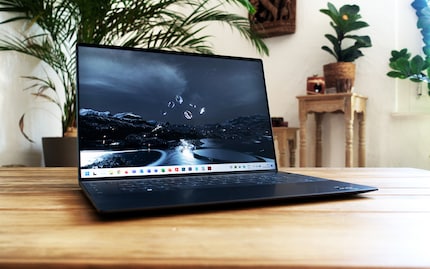
The 13.4-inch display has a border of only four millimetres at the sides. At the top, it is six millimetres, as there is room for the 720p front camera and infrared camera. The latter makes it possible to log in using facial recognition. A fingerprint sensor is integrated in the power button. The screen-to-body ratio of the device is 91.9 per cent.
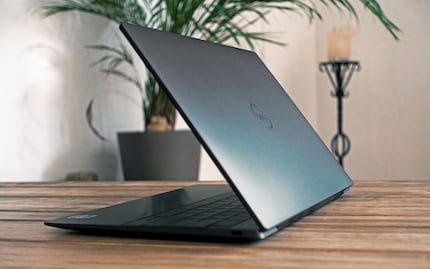
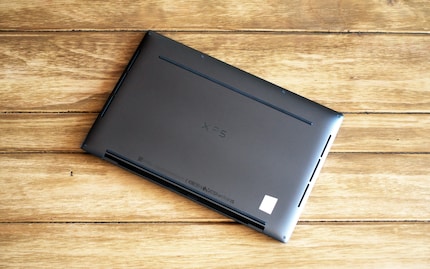
The lid is emblazoned with a milled Dell logo. This is complemented by an XPS logo on the bottom of the laptop. Otherwise, six star screws, two non-slip rubber pad strips and side speaker slots show upside down. The processor cooling vents can be found between the display hinges.
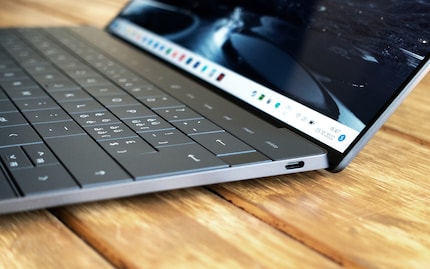
Dell is stingy when it comes to the number of ports. But at least the two Thunderbolt 4 ports are state of the art. They are USB-C compatible, support DisplayPort and offer data rates of up to 40 gigabits per second. There is one on each side. The notebook can also be charged via Power Delivery, which means that only one port remains for peripherals. It is recommended to purchase a corresponding hub. An adapter for USB-C to USB-A 3.0 is included in the scope of delivery, which means that at least a wired mouse or an older USB stick can also be connected.
Display with touch support
I find the 1920 × 1200 pixel resolution to be razor sharp at 13.4 inches diagonal with an arm's length distance. It also enables the native display of Full HD video material. And on top of that, there's multi-touch. Although the display surface is glossy, it is actually, as stated in the specs, less reflective than, for example, the Yoga i9 from Lenovo, which I also have to hand right now - or an Apple MacBook Air. That's what I like about this IPS panel - as well as the fact that the colour display looks natural and rich.
I find out how good the display actually is and how bright it shines by measuring it with the x-rite i1Display Pro Plus.
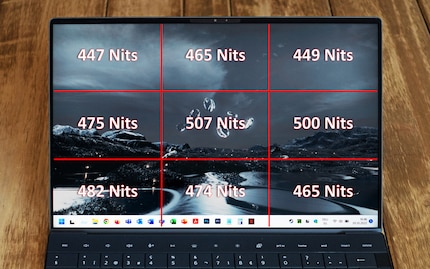
Dell promises a maximum brightness of 500 nits on this display, which is a top figure for a notebook - I'm happy at 300 nits and above, and happy at 400. The actual average luminance at the highest brightness level on the test device is 474 nits.
What I like about the bluetooth display is that it's very bright.
What is hardly noticeable to the naked eye, but still bothers me somewhat, is the uneven illumination. The biggest drop is from the centre to the top left and amounts to 60 nits - that's an 11.83 per cent difference.
When looking at the screen, I can hardly see the difference.
With regard to the display, the colour space sRGB, which is commonly used for working and surfing, is displayed correctly to 99 per cent - that's how it should be. However, for the DCI-P3 colour space, which is important for digital film production, I only measured 75 per cent, which is not enough for professional video editing. And the colour space Adobe RGB, which is important for the creation of print templates, achieves a coverage of 72.3 per cent - too little for graphic artists, photographers and polygraphers. When I measure the black and white values, the calculated static contrast is a crisp 1866:1.
Keyboard and touchpad
When I look at a function key on a normal keyboard, it has "F5" printed on it as well as the secondary function that can be reached by pressing FN, for example the play symbol. In contrast, the LED function key bar of the XPS 13 Plus only shows the label that is triggered by pressing it. If I press the function key, the display changes from Play to F5. If you have switched off the backlighting of your keys, the function keys light up in a discreet white. If you switch the illumination to level one or two, the LED bar scales accordingly. I can't see any advantages over normal keys, but I can't see any disadvantages either. So I quickly get used to touching instead of pressing.
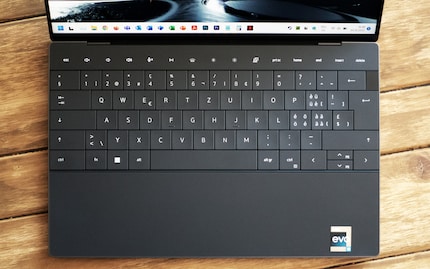
Apart from the generous layout, the keys have a travel of one millimetre. When you press down this millimetre, you feel a haptic feedback right at the beginning of the key travel. The resistance is stronger than on other laptop keyboards and is barely audible. After that, the keys spring back pleasantly and quickly. I like the fact that I can type with more pressure - the keyboard is not only visually appealing.
I can say almost the same about the touchpad, which is located below the space and Alt-Gr keys. Which, by the way, is easy to see in the thermal image at the end of the article. The touch surface lets me control the mouse pointer quickly and precisely - with one exception: with sweaty fingers, the surface feels less smooth and I need a bit more momentum when pushing the pointer. When I press the right or left mouse button, the surface yields under about the same pressure as the keyboard keys - accompanied by a quiet click. By the way, the fact that the touchpad is frameless only irritates me for the first hour - after that, I always place my finger within the invisible borders.
Speakers
The speakers on the XPS are mostly good for the office, video calls and Netflix on holiday. Still, they only halfway convince me.
Positive: Voices, some classical music or other classics like "Around The World" by Daft Punk sound good to excellent with the notebook. Of course, considering the puny 4-watt drivers and compared to other notebook speakers. There are clean highs, mids and even basses. In addition, the sound has a good stereo effect, which, when listening with closed eyes, suggests a lot more distance between the right and left speakers than is actually there.
Negative: However, when I listen to other genres, such as rock or industrial, the sound seems clipped and what was just enjoyment becomes mush. Electric guitars, in particular, sound like they're coming out of a can and have a background effect on the overall sound. Some of the worst of these are songs by Rammstein, which I regret.
Battery performance with continuous video streaming
During continuous video streaming, I test how long the 55 Wh battery of the XPS lasts when streaming "Stranger Things" on Netflix at around 400 nits peak brightness. This corresponds to the second-highest brightness level on the test device.
The notebook streams for 8 hours and 37 minutes before it runs out of juice. For comparison: Using an Apple MacBook Air M2 with a 52.6-Wh battery and a 0.2-inch-larger 13.6-inch display, I'm at the same test came to 6 hours and 42 minutes - with MacBook Air M1 (49.9 Wh) and 0.1 inch smaller display to 9 hours and 18 minutes. And with Lenovo's Yoga 9i, with 0.6 inches more diagonal and 75 Wh, it's a total of 10 hours and one minute.
Battery performance when working in a mobile office
If I hold back on excessive video calls, I can spend around one and a half working days with the notebook in the mobile office before it has to be plugged in again. I am satisfied with the battery.
Processor performance: Cinebench R23 and Geekbench 5
The good thing about the twelfth generation and the Intel Core i5-1240P installed here is that it has many cores and these are divided into performance and efficiency cores. Four Hyper-Threading capable performance cores provide a lot of power with up to 4.4 GHz - and eight efficient cores take over work that can also be done best with less power. This helps to save power.
Now let's look at how much the processor performs when it's at full throttle:
The CPU benchmark Cinebench from Maxon tests how well the processor performs when rendering 3D models. In the R23 version, the result is no longer determined on the basis of a single run, but on the basis of the work done within ten minutes. This is good, because it means that poor cooling concepts perform somewhat more realistically.
As a second processor benchmark, I run Geekbench 5. Using simulated real-world scenarios, the CPU is tested in single-core and multi-core operation. Testing takes only a short time and can therefore lead to relatively good results even on poorly cooled devices. The benchmark runs on Windows, MacOS, Linux, Android and iOS. This also enables cross-comparisons among different processor architectures, which should be enjoyed with caution. With x86-based processors, only one thread and thus not the entire (performance) core is utilised in single-core mode. ARM systems, on the other hand, use an entire core and thus have an advantage. This is another point that should be taken into account when comparing results in the Geekbench browser.
| Benchmark | Resultat: Dell XPS 13 Plus
(i5-1240P) | Resultat: Lenovo Yoga 9i
(i7-1260P) | Resultat: Apple MacBook Air
(M2) | Resultat: Microsoft Surface Laptop Go 2
(i5-1135G7) | Resultat: Microsoft Surface Pro 8
(i7-1185G7) |
| Cinebench R23 – CPU Multi Core | 6829 Punkte | 10 094 Punkte | 7749 Punkte | 3450 Punkte | 4818 Punkte |
| Cinebench R23 – CPU Single Core | 1613 Punkte | 1651 Punkte | 1581 Punkte | 1313 Punkte | 1508 Punkte |
| Geekbench 5 – CPU Multi Core | 7177 Punkte | 10 326 Punkte | 8985 Punkte | 1409 Punkte | 5920 Punkte |
| Geekbench 5 – CPU Single Core | 1611 Punkte | 1742 Punkte | 1915 Punkte | 501 Punkte | 1562 Punkte |
The results in Cinebench R23 are better with the 12th Gen i5 of the XPS than with an 11th Gen i5 (Microsoft Surface Laptop Go 2) or i7 (Microsoft Surface Pro 8). The XPS is around 50 and 30 per cent more powerful in the multi-core test, and around 29 and 7 per cent more powerful in the single core test. Compared to the 12th Gen i7 (Lenovo Yoga 9i), however, there is room for improvement, as it manages over 10,000 points in Multi Core. In single core, however, the i5 is practically equal to the i7 of the same generation with only 38 points less. The MacBook Air M2 (4 performance and 4 efficiency cores) scores 7749 Multi Core points and 1581 Single Core points in Cinebench R23.
The XPS results in Geekbench 5 roughly match those of Cinebench when compared with other laptops. The 12th Gen i5 turns out to be a top workhorse whose performance is enough for much more than just office work. However, gaming or other graphically challenging applications are left out due to a lack of a potent graphics card.
Graphics performance: 3DMark Night Raid
3DMark Night Raid is designed to test the graphics performance of devices with integrated GPUs. It is effectively a performance meter for PC gaming at the lowest level. The Intel Core i5-1240P of the XPS 13 Plus has integrated Intel Iris Xe Graphics with 80 Execution Units and up to 1.3 gigahertz clock speed.
The XPS achieves a Night Raid score of 13 188 (16 129 graphics points and 6487 CPU points). With a Surface Laptop Go 2, there is surprisingly a bit more in this benchmark: 13 571 points (18 011 graphics / 5662 CPU). There's just as much more with the Surface Pro 8 at 18 105 points (21 937 graphics / 9099 CPU) and the Yoga 9i at 18 457 points (22 089 graphics / 9555 CPU).
Although the XPS scores less well than expected on Night Raid, it must be remembered that any integrated graphics chips perform sub-par compared to a dedicated graphics card, but are perfectly adequate away from gaming or other rendering tasks. Therefore, the less potent result is bearable.
Office performance: PCMark 10
Thanks to PCMark 10 from 3DMark, PCs and notebooks can be tested for the diverse tasks at a workplace. So how fast programs open, how well browsing, word processing or video conferencing works and much more.
The XPS 13 Plus scores 5032 points, making it a top office device. That's more than the Microsoft Surface Laptop Go 2 with 11th Gen i5 (4270 points) and the same as the Surface Pro 8 with 11th Gen i7 (5042 points). Lenovo's Yoga 9i scores 5640 points with 12th Gen i7 - a plus of 12 percent compared to the 12th Gen i5.
Stress test: CPU performance, cooling power, heat development and volume
The stress test shows how well the cooling does its job under sustained continuous load. I use AIDA64 to keep the hardware busy. During an initial quick test, I notice that the processor's graphics take up 24 per cent of the cooling power at 100 per cent load. 30 seconds after starting the test, the CPU throttles down.
Since I want to know how long the CPU can deliver its full performance, I do not use the graphics to the same extent in the stress test. How long the battery lasts is secondary. I stress: CPU, FPU, cache and RAM.
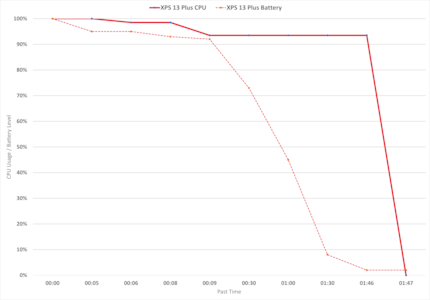
During the test, the processor behaves as follows: A 100 per cent CPU load is given for five minutes. After that, the CPU throttles down to a fluctuating 98 to 99 percent. Two minutes later, it clocks down again: to a fluctuating 91 to 97 per cent. The CPU load then remains there for the rest of the time before the notebook shuts down after one hour and 46 minutes due to the empty battery. The cooling does a good job with this behaviour. There are some laptops that do a much worse job.
The temperatures of the individual cores of the processor rise briefly to 100 °C during the test. According to Intel, the CPU is allowed to get this hot. After that, the temperatures settle at 71 to 77 °C, which is cooler than, for example, the Lenovo Yoga 9i with 12th Gen i7, whose core temperatures hovered between 83 and 100 °C during the same test.
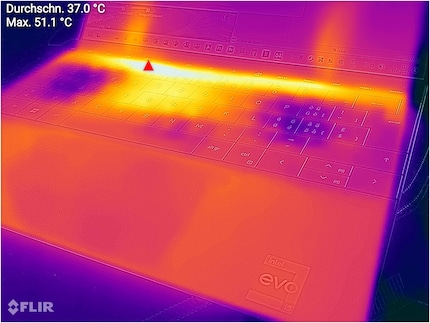
If I take a thermal image, according to the FLIR cam on my Cat S62 Pro, the case measured up to 51.1 °C during testing. On the Yoga 9i, it was 60 °C.
When I simultaneously measured the volume with a sound level meter from Testo, the fan could be heard at 35.9 decibels from a sitting position. From a distance of 30 centimetres, it is 40.5 decibels. That makes it as quiet as the Lenovo Yoga 9i. In normal use, I don't notice the ventilation of the XPS 13 Plus.
Conclusion: Small, beautiful, strong, but not perfect
Small devices often do it to me. Especially when the workmanship, the design and the quality of the components used are up to scratch. That is almost all the case with the Dell XPS 13 Plus 9320 Touch
.
A powerful 12th gen processor is enough for much more than office work. For editing films, for example. However, this version of the laptop only offers Full HD and not true colour reproduction. However, thanks to 99 per cent coverage in sRGB, this is still perfectly suitable for normal work and surfing. This is also fun with the bright, if not perfectly illuminated, display thanks to the thin edge and multi-touch. Just like the keyboard with its generous layout, its special appearance and the somewhat harder stroke.
All in all, I am very happy with the XPS 13 Plus and have to admit that after a few weeks I am reluctant to give it away. I can recommend it with a clear conscience - even if it should have more ports and the price is a bit high.
I find my muse in everything. When I don’t, I draw inspiration from daydreaming. After all, if you dream, you don’t sleep through life.


